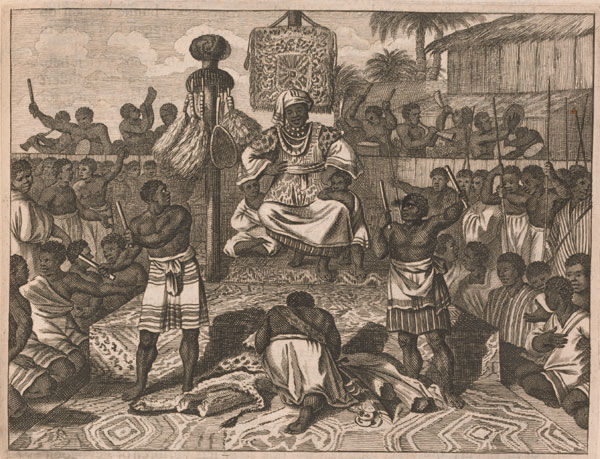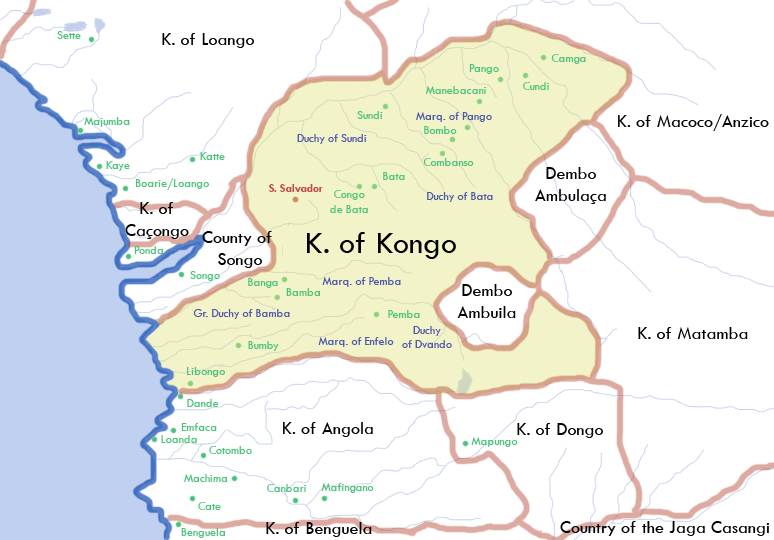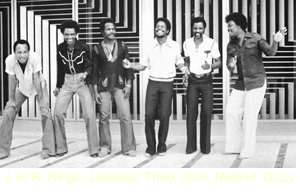Mbote ndekos and mwasis, this is volume 2 of the series. Let's dive right in.
KINGDOM OF KONGO roots
To locate the birthplace in Africa of Rumba, you have to look at the Congo basin side and inside the territory that made up the Kingdom of Kongo whose capital M'Banza Kongo or San Salvador was in Angola. "(Page 13)


Kongo music was varied and was performed according to events, situations.
Among the most popular dances, there was the "navel dance", during which the two partners rub the navel. "Navel" is said to be " Kumba " in kikongo (or Mu-Kumba). The slaves originating from the Kongo kingdom who land in Cuba are keen to make their cultural heritage prosper, especially since the slaves are authorized to regroup in "calbidos", that is to say "black associations of same ethnic origin. " The ceremonies organized by these "calbidos" are all occasions to find the dances, the rites of the land of Africa which is always present in their memory.
Thus, The second part of Clément Ossinondé's work not only provides information on music, it is also a section of the history of Cuba that is offered to the reader. The Kumba, belly dance performed in circumstances such as the birth of twins, will become the Rumba, " depending on the deformation, let's even say the particular pronunciation of the Spanish masters " (page 34).

From Kumba to Rumba, what evidence, do you want to shout, and yet the idea would not have crossed my mind if I had not read Ossinondé. The book has only fifty pages, it reads quickly and allows you to take a quick tour of Congolese rumba. The great names of this music who have distinguished themselves on both banks of the Congo River are cited from the beginning of the work. Twenty, including Joseph Kabassele, whose name is definitively linked to a song that has taken on the value of an anthem, according to David Van Reubrouck, who has written an exciting book on the Congo. Here is what he writes from the testimony of Charly Henault, the Belgian drummer of the African Jazz (" I was white, but what importance? I was a drummer in a country full of drummers "), testimony collected in 2008 :
" They started at the Plaza Hotel to concoct a song that would soon become one of the greatest successes of Congolese music: Cha-cha independence . The text, in Lingala and Kikongo, was delighted with the newly acquired autonomy, praised the collaboration of the different parties and sang the big names of the struggle for independence: "Independence, cha-cha, we got it, / Oh! Round table, cha-cha, we won! "After 1960, the Congo was going to receive different national anthems, at the time of Kasavubu, at the time of Mobutu, at the time of Kabila, from pompous compositions to texts pathetic, but throughout these last fifty years there has been only one true Congolese national anthem, one single tune which until today spontaneously swayed all of Central Africa: playful music , light and moving of cha-cha independence . "
THE TRUE HISTORY OF SOUKOUSS RHYTHME. Don Fadel is one of these little-known geniuses. He is writing the history of Congolese music. For him the roumba comes from Congo-Brazzaville, as well as the soukous. To support his arguments, he carried out fieldwork in Brazzaville and Kinshasa. He interviewed Diaboua, Wendo. Video interviews of more than one hour with Diaboua will be used. This work will be the subject of a publication entitled "History at the Place".
Don Fadel
You learn first-hand information.
For example, Diaboua was the first master of Jean-Serge Essou. He taught her the flute then offered her his first clarinet. Diaboua was the first musician to introduce congas into the Congolese roumba. To Kabassélé’s great surprise, said Kalé Jeff, Diaboua suggested inserting the percussions in the song Parafifi. It worked. Before, groups like Victoria Brazza by Paul Kamba used the paténgués (rectangular tambourines). Since then, we can no longer do without congas in Congolese music.
Don Fadel wishes to restore the historical truth. He goes back to the sources, notably on the other bank of the Congo river to discuss with the actors of the early hours of the roumba.
" What do you want ? Who are you ? Yelled Wendo when Don Fadel landed at his home in Kinshasa to investigate the origins of the roumba.
“I am a Congolese citizen. I'd like to interview you, "said Don Fadel.
"Yeah, I imitated Victoria Brazza in 1948," said Wendo Kolosoy.
"In fact, this patriarch had poached a musician from Victoria Brazza to reinforce Victoria Kin" explains Don Fadel.
When Rocheraud says after his stint at Olympia in 1969 that he is the father of the Soukous, it makes Don Fadel laugh.
“Everything is reversed. Things will have to be put back in place, "promises this ethnomusicologist.
"The soukous was born in Ouénzé with the Sinza orchestra. The person who will popularize this rhythm is Pamelo Mounka. Walking through the night in Ouénzé, Pamélo intends to play an orchestra at the Vis à Vis bar. It was Sinza Kotoko. The rhythm pleases him. He composes "Mama na mwana" on this tempo .
It was a great success. But Pamelo Mounka is just a mediator.
In truth, the soukous was born in 1959 thanks to a musician named Ibombon with his group Air Mambo. Ibombon played in a bar next to the Ouénzé market. Accountant by trade, Ibombon is assigned to Dolisie. He then decides to sell his material to the young musicians of the rue Mouila who had just created Sinza Kotoko (Mousse, Ya Gabi, Don Fadel…)
"I leave the material for a small fee, but I also leave you a rhythm. Take advantage of it. "
"The advice does not fall on deaf ears. Piere Mountouari composes the song Vévé and Ma Loukoula whose swing has toured Africa. The soukous was born from there ”notes Don Fadel. Full Link (
http://www.congopage.com/Don-Fadel-revisite-avec-brio-les)
The legacy of Sinza Kotoko and the Soukous rhythm

The "Soukous" one of the genres of modern Congolese music to be recognized internationally is a creation of Sinza Kotoko. Orchestration with traditional music and dance accents "Kongo", with as main director, the irremovable solo guitarist Jacques Kimbembe "Mous".
"My Loukoula"
If you want to get an idea of what Rumba "Soukous" was yesterday, just listen to "Ma Loukoula". The refined dialogue of voices and instruments: the little folk side, now gone, has not been emulated. Especially in the preponderant importance represented by the bass; and the more sought-after, more complex rhythmic textures, forcing dancers to invent new steps.
At that time, everything was done "by hand": no electronic percussion or synthesized brass. Real sax, like in the good old days of "Walla". And a man to type with modulation the skins of the Tumbas. Typical music in all its enjoyable splendor. But unfortunately ! Sinza has not been in this world since the 80s.
For the record, 1964 reminds us of the creation of the “Super Tumba” orchestra; Ouénzé orchestra which - after Orphée Jazz - won fame in Brazzaville. It is thanks to its main actors Gabriel Dianzolo, Jacques Kimbembe, Anatole Bokassa and Hyacinthe Malonga, that the orchestra "Super Tumba" was born in 1964, at the bar "Vis-à-vis" Ouénzé, before becoming Sinza "Kotoko" in 1965. In 1968 Pierre Mountouari arrived who played an important role in strengthening the group. In particular with the launch of successful titles like "Veve", "Ma Loukoula", "Mavoungou" ... published by Pathé Marconi editions, the result of a coherent and solid team.
1973 - Sinza Gold medal of the 1st Pan African Cultural Festival in Tunis
The most phenomenal success of the Sinza orchestra is its participation in Tunis in June 1973 in the First Pan African Cultural Festival of Youth. He seduced a whole people, to the point where despite the charismatic presence of Tabu Ley and Afrisa, did not prevent Sinza from obtaining the Festival's gold medal. Sinza had succeeded by refusing the facility offered by the vogue "Disco" and "Soum Joum", to play music based on the tradi-modern "Soukous" which showed that the group had perfectly assimilated the ideas launched by the singers Ange Linaud Djendo and Théophile Bitsikou "Théo",. Both were part of the Congolese delegation .
And then a musical genre in its own right, the "Soukous" which has crossed all eras and all styles, producing perhaps the most creative in the history of Congolese music.
Link (
http://www.dac-presse.com/sinza-kotoko-plus-grand-orchestre-soukous-annees-70/)
The influence of guitarist Huit Kilos.
Nseka Huit Kilos Bimwela's swift arpeggios would be later be the archetype of the Kumba-Soukouss tone. Listen to a young
14-yr old Huit Kilos on
Dindo Yogo & Orch. Macchi's Lola Muana.The influence of Drummer Ya Meridjo!:format(jpeg):mode_rgb():quality(90)/discogs-images/A-5776639-1565798390-4526.jpeg.jpg)
In 1973, Zaiko Langa Langa would changing it's drumming structure. Meridjo adds a new rhythm called "Machine Ya Kauka" inspired by the sounds of th train movement (
http://www.mbokamosika.com/article-belobi-meridjo-createur-du-tempo-machine-ya-kauka-68531525.html). You can hear the "Machine Ya Kauka" on such melodies such as Eluzam, Mbeya Mbeya and much more.
Prince Nico's Sweet MotherPrince Nico Mbarga is a Nigerian/Cameroonian musician that revolutionize Afrikan Music with his timeless's hit "Sweet Mother". One of the most known songs from the continent.
It was a love song from a son to a mother that, in its old-fashioned way, never actually once says “I love you.” Instead, it’s a grateful son praising what his mother did for him as a child: drying his tears, putting him to bed, feeding him, praying when he’s ill:
When I dey hungry my mother go run up and down / she dey find me something when I go chop oh! / Sweet Mother a-aah / Sweet Mother oh-e-oh!
And if “Sweet Mother” was dedicated to all mothers and the things they do for children, it was inspired by the loving sacrifices Mbarga saw his own mother, a widowed farmer, make after his father died. The lyrics began, “Sweet Mother, I no go forget you, for dey suffer wey you suffer for me.”
For six months Mbarga – now calling himself Prince Nico Mbarga – Rocafil and Rogers All Stars worked on “Sweet Mother,” rehearsing daily from seven in the morning until one in the afternoon. It was, says Rocafil rhythm guitarist, Cameroonian Jean Duclair, “real every day work,” as they made change after change, turning it from a gentle “cha cha cha” to a more upbeat highlife sound, adding little dance breaks, and crafting a song marked more and more by the drive of Mbarga’s Congolese-style finger-picking lead guitar.
Finally satisfied, the band travelled across the country to record, and after a heavy night in a Lagos hotel, with all but Mbarga drinking and smoking, recorded it live at Decca Studios – hung over for sure, but they had practiced so much it hardly mattered.
And what was the reason for its success? Certainly, with its Congolese guitar-picking, its West African highlife beat and its pidgin lyrics, “Sweet Mother” had something for people all over.
Oliver de Coque. Nigerian guitarist inspired by Kongo
:format(jpeg):mode_rgb():quality(40)/discogs-images/R-1436220-1378804263-9520.png.jpg)
Oliver de Coque during his lifetime was an accomplished musician who became popular with his brand of highlife. He started playing music in 1974 after he learnt how to play guitar from Piccolo and he has about 86 albums to his credit. He played a major role during civil war playing music for the Biafran soldiers.
Together with Chief Stephen Osita Osadebe and the various Orientals off-shoots, Oliver De Coque (b. Oliver Sunday Akanite) can be considered one of the prime exemplars of and chief innovators in contemporary Igbo popular music. Of these musicians, he has done the most to integrate contemporary highlife and traditional Igbo music. Indeed, his trademark "system" or "style" takes its name from the Ogene, a double-headed bell used in traditional Igbo music. One of Africa's greatest guitarists, he has been much inspired by Congolese soukous, and this is shown to good form in such releases as 1985's "Nne Bu Oyoyo / Ezigbo Nna." "Omumu Onye Nzoputa (Jesu Kristi) / Olu Ebube Nke Onye Nweayi" from 1983 shares a guitar line with the tune "Nanu Lubutu" by Congolese group Minzoto Wella-Wella.
De Coque hails from Ezinifite, Nnewi South LGA, Anambra State, and got his musical start in 1965 at the age of 17 playing ekpili, a form of Igbo traditional music. In 1970, following the defeat of the Biafran war of independence, he got a job playing with a Lagos group, Sunny Agaga & his Lucky Star Band. Shortly after he engaged with Jacob Oluwole & his Friendly Unity Band, and was featured on their hit "Agbasisi." De Coque's stint with this group was also short-lived, and in 1973 he took up with Sule Agboola & his Moonlight Star Band.
As this discography shows, De Coque has continued into the '90s with his usual fecundity. In addition to his singing career he has also branched out into the acting field, appearing in several Nigerian video releases. While De Coque still delivers a great stage show, his last few releases have been rather weak. His younger brother Eugene, however has ably carried on the "Ogene" tradition with his updated "Igede" sound (see his separate discography below).
He sadly died of Cardiac arrest on June 20, 2008.
Here's a piece of his powerful guitar playing! You can hear the "Franco" influence
How the Kongolese sound went to Abidjan!Sam Mangwana & African All Stars

African All Stars, influential but short-lived Congolese rumba band, formed 1978; disbanded 1979. Théo Blaise Kounkou (born Brazzaville, 1949; vocal), Lokassa ya Mbongo (born Kinshasa, 1946; guitar), Dizzy Mandjeku (born Kinshasa, Aug. 20, 1946; guitar), Sam Mangwana (born Kinshasa, Feb. 21, 1945; vocal), Ringo Moya (born Kinshasa, 1953; died Paris, Apr. 1993; drums), Roland M'vogo (born Cameroon, bass).
Band formed in Abidjan, Côte d'Ivoire, where a number of Congo-Kinshasa (Zaire) musicians, disillusioned with economic and political conditions at home, had gone to seek a fresh start. Mangwana, Lokassa, Mandjeku and Moya, four veterans of Tabu Ley's band, Afrisa, joined with Congo-Brazzaville's Kounkou and Cameroonian M'vogo to launch their new band.
The All Stars felt Congolese dominance of African pop music to be under threat from pressing plants at home, idled by lack of raw materials and spare parts, and from a certain absence of artistic innovation. It was the time of "Sweet Mother" from Nigeria's Prince Nico Mbarga, who fashioned a mixture of West African highlife and Congolese-style guitars into a world-wide hit. To counter Mbarga's challenge, the All Stars speeded up the rumba (Congolese music's base) and de-emphasized conventional Lingala lyrics in favor of more widely understood French and English.
With help from a Nigerian producer, the players traveled to Lagos in the middle of 1978 where, in little more than twenty-four hours, they recorded enough material for three albums: Sam Mangwana et l'African All Stars, Les Champions, and Zeneba. Most of the songs incorporated the speeded-up "new beat," but a laid-back rumba called "Georgette Eckins" produced the session's runaway hit. The All Stars played concerts along the West African coast and, while in Ghana in early 1979, recorded four albums of new material: Est-ce Que Tu Moyens?, M'banda Kazaka, Mamadou, and Suzana Coulibaly. A faster, "new beat" song, "Suzana Coulibaly," produced the biggest hit of these sessions.
Also in 1979, the group moved its headquarters from Abidjan to Lomé, Togo, where it was joined by three additional guitarists from Kinshasa: Pablo Lubadika, Bopol Mansiamina, and Syran M'Benza. By then, however, dissension had begun to mount. After recording a final album, Matinda, in Lagos, the African All Stars broke up, ending a brief but extraordinarily creative year of existence. A reunion of Lokassa, Mandjeku, Mangwana, and Moya in 1982 produced three new albums—Affaire Video, N'simba Eli, and Bonne Année—under the African All Stars name, but all lacked the fire and spontaneity of the group's original work.
Despite its brief existence, the African All Stars proved to be tremendously influential. They demonstrated to other musicians that there could be artistic life outside of Kinshasa and Brazzaville. (
http://rumbaontheriver.com/allstars.html).
Another obscure band came on the scene in Abidjan from Kongo (Zaire). This was called Micky Micky led by percussionist Mavos Meme Mavungu
Other musicians such as Nyboma Canta of Lipua Lipua, Bella Bella and Kamale went to Abidjan. In fact, this is where he released his biggest hit - Double Double with Dally Kimoko on solo.
:format(jpeg):mode_rgb():quality(40)/discogs-images/R-9214427-1476792929-1186.jpeg.jpg)
Dally Kimoko

Tchico Tchicaya of Bantous de la Fame fame went to Abidjan as well. From Congo Brazza
